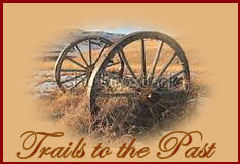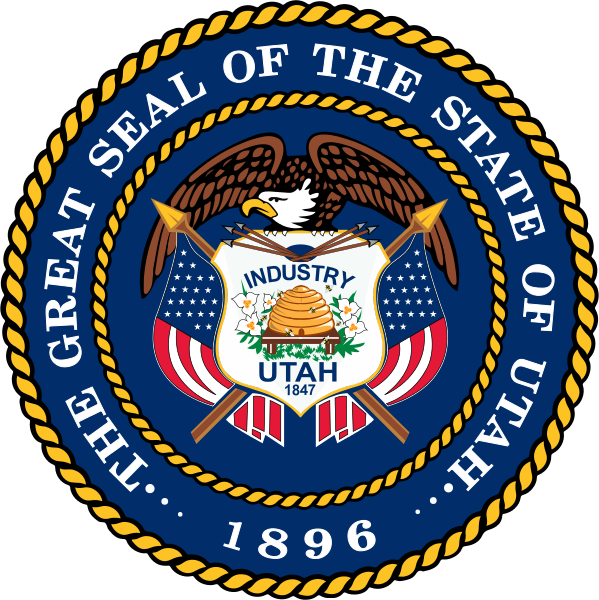|

Trails to the Past of Utah is requesting any genealogy materials that you may have such as Obituaries, News Clippings, Wills, Deaths, Births, and Marriages, You do not need the certificates, but only the source of the information. If you should happen to have any of these items, please email them to Marie Miller, the State of Utah Administrator. Thank you.

It became the 45th state admitted to the Union on January 4, 1896. The world headquarters of The Church of Jesus Christ of Latter-day Saints (LDS Church) is located in Utah's state capital, Salt Lake City.
Another group of Native Americans, the Navajo, settled in the region around the 18th century. In the mid-18th century, other Uto-Aztecan tribes, including the Goshute, the Paiute, the Shoshone, and the Ute people, also settled in the region. These five groups were present when the first European explorers arrived.
The southern Utah region was explored by the Spanish in 1540, led by Francisco Vasquez de Coronado, while looking for the legendary Cibola. A group led by two Catholic priests sometimes called the Dominguez Escalante Expedition left Santa Fe in 1776, hoping to find a route to the coast of California. The expedition traveled as far north as Utah Lake and encountered the native residents. The Spanish made further explorations in the region, but were not interested in colonizing the area because of its desert nature. In 1821, the year Mexico achieved its independence from Spain, the region of Utah became part of Mexico, as part of Alta California.
Trappers and fur traders explored some areas of Utah in the early 19th century. The city of Provo, Utah was named for one of those men, Etienne Provost, who visited the area in 1825. The city of Ogden, Utah was named after Peter Skene Ogden, a Canadian explorer who traded furs in the Weber Valley.
In late 1824, Jim Bridger became the first white person to sight the Great Salt Lake. Due to the high salinity of its waters, Bridger thought he had found the Pacific Ocean; he subsequently found that this body of water was nothing but a giant salt lake. After the discovery of the lake, hundreds of traders and trappers established trading posts in the region. In the 1830s, thousands of people traveling from the East toward the U.S. West began to make stops in the region of the Great Salt Lake, then known as Lake Youta.
Following the death of Joseph Smith in 1844, Brigham Young as president of the Quorum of the Twelve became the effective leader of the Latter Day Saints in Nauvoo, Illinois. To address the growing conflicts between his people and their neighbors, Young agreed with Illinois Governor Thomas Ford in October 1845 that the Mormons would leave by the following year. Brigham Young and the first band of Mormon pioneers came to the Salt Lake Valley on July 24, 1847. Over the next 22 years, more than 70,000 pioneers crossed the plains and settled in Utah. For the first few years, Brigham Young and the thousands of early settlers of Salt Lake City struggled to survive. The barren desert land was deemed by the Mormons as desirable as a place where they could practice their religion without harassment. Utah was the source of many pioneer settlements located elsewhere in the West. Salt Lake City was the hub of a "far-flung commonwealth" of Mormon settlements. Fed by a continuing supply of church converts coming from the East and around the world, Church leaders often assigned groups of church members to establish settlements throughout the West. Beginning with settlements along Utah's Wasatch front (Salt Lake City, Bountiful and Weber Valley, and Provo and Utah Valley), irrigation enabled the establishment of fairly large pioneer populations in an area that Jim Bridger had advised Young would be inhospitable for the cultivation of crops because of frost. Throughout the remainder of the 19th century, Mormon pioneers called by Brigham Young would leave Salt Lake City and establish hundreds of other settlements in Utah, Idaho, Nevada, Arizona, Wyoming, California, Canada, and Mexico including in Las Vegas, Nevada; Franklin, Idaho (the first white settlement in Idaho); San Bernardino, California; Star Valley, Wyoming; and Carson Valley, Nevada.
Prominent settlements in Utah included St. George, Logan, and Manti (where settlers completed the first three temples in Utah, each started after but finished many years before the larger and better known temple built in Salt Lake City was completed in 1893), as well as Parowan, Cedar City, Bluff, Moab, Vernal, Fillmore (which served as the territorial capital between 1850 and 1856), Nephi, Levan, Spanish Fork, Springville, Provo Bench (now Orem), Pleasant Grove, American Fork, Lehi, Sandy, Murray, Jordan, Centerville, Farmington, Huntsville, Kaysville, Grantsville, Tooele, Roy, Brigham City, and many other smaller towns and settlements. Young had an expansionist's view of the territory that he and the Mormon pioneers were settling, calling it Deseret which according to the Book of Mormon was an ancient word for "honeybee" hence the beehive which can still be found on the Utah flag, and the state's motto, "Industry."
Utah was Mexican territory when the first pioneers arrived in 1847. Early in the Mexican-American War in late 1846, the United States had captured New Mexico and California, and the whole Southwest became U.S. territory upon the signing of the Treaty of Guadalupe Hidalgo, February 2, 1848. The treaty was ratified by the United States Senate on March 11. Learning that California and New Mexico were applying for statehood, the settlers of the area (originally having planned to petition for territorial status) applied for statehood with an ambitious plan for a State of Deseret.
The Utah Territory was much smaller than the proposed state of Deseret, but it still contained all of the present states of Nevada and Utah as well as pieces of modern Wyoming and Colorado. It was created with the Compromise of 1850, and Fillmore, named after President Millard Fillmore, was designated the capital. The territory was given the name Utah after the Ute tribe of Native Americans. Salt Lake City replaced Fillmore as the territorial capital in 1856.
Disputes between the Mormon inhabitants and the U.S. government intensified due to prejudice against The Church of Jesus Christ of Latter-day Saints in the Northeast and the practice of plural marriage, or polygamy, among its members. The Mormons were still pushing for the establishment of a State of Deseret with the new borders of the Utah Territory. Most, if not all of the members of the U.S. government opposed the polygamous practices of the Mormons. In the 1890 Manifesto, the LDS Church banned polygamy. When Utah applied for statehood again, it was accepted. One of the conditions for granting Utah statehood was that a ban on polygamy be written into the state constitution. This was a condition required of other western states that were admitted into the Union later. Statehood was officially granted on January 4, 1896.
On May 10, 1869, the First Transcontinental Railroad was completed at Promontory Summit, north of the Great Salt Lake. The railroad brought increasing numbers of people into the territory and several influential business people made fortunes there.
|
On Line Data
|
|

|
Neighboring
States
Arizona, Colorado, Idaho, Nevada, New Mexico, Wyoming
Utah Family Group Sheet Project
Utah Counties
|
County
|
Date Formed
|
Parent County
|
County Seat
|
| Beaver |
05 Jan 1856 |
Iron, Millard |
Beaver |
| Box Elder |
05 Jan 1856 |
Unorganized Territory |
Brigham City |
| Cache |
05 Jan 1856 |
Unorganized Territory |
Logan |
| Carbon |
08 Mar 1894 |
Emery |
Price |
| Daggett |
07 Jan 1918 |
Uintah |
Manila |
| Davis |
03 Mar 1852 |
Salt Lake |
Farmington |
| Duchesne |
04 Jan 1915 |
Wasatch |
Duchesne |
| Emery |
12 Feb 1880 |
Sanpete, Sevier |
Castle Dale |
| Garfield |
09 Mar 1882 |
Iron, Sevier, Kane |
Panguitch |
| Grand |
13 Mar 1890 |
Emery, Uintah |
Moab |
| Iron |
03 Mar 1852 |
Unorg. Terr. |
Parowan |
| Juab |
03 Mar 1852 |
Original County |
Nephi |
| Kane |
16 Jan 1864 |
Washington, Unorganized Territory |
Kanab |
| Millard |
04 Oct 1851 |
Juab |
Fillmore |
| Morgan |
17 Jan 1862 |
Davis, Summit |
Morgan |
| Piute |
16 Jan 1865 |
Sevier |
Junction |
| Rich |
16 Jan 1864 |
Cache |
Randolph |
| Salt Lake |
03 Mar 1852 |
Original County |
Salt Lake City |
| San Juan |
17 Feb 1880 |
Kane |
Monticello |
| Sanpete |
03 Mar 1852 |
Original County |
Manti |
| Sevier |
16 Jan 1865 |
Sanpete |
Richfield |
| Summit |
13 Jan 1854 |
Salt Lake |
Coalville |
| Tooele |
03 Mar 1852 |
Original County |
Tooele |
| Uintah |
18 Feb 1880 |
Wasatch |
Vernal |
| Utah |
03 Mar 1852 |
Original County |
Provo |
| Wasatch |
17 Jan 1862 |
Summit |
Heber City |
| Washington |
03 Mar 1852 |
Unorg. Terr. |
St. George |
| Wayne |
10 Mar 1892 |
Piute |
Loa |
| Weber |
03 Mar 1852 |
Original County |
Ogden |
The information on Trails to the
Past � Copyright may be used in personal family history research, with source citation. The pages in entirety may not be duplicated for publication in any fashion without the permission of the owner. Commercial use of any material on this site is not permitted. Please respect the wishes of those who have contributed their time and efforts to make this free site possible.~Thank you!
|


